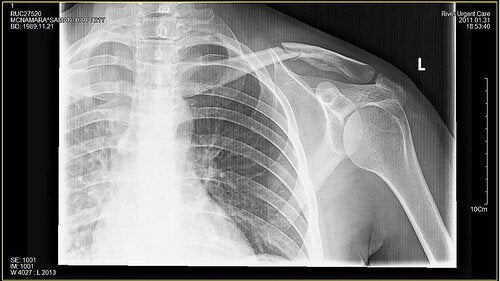
The spread of radiation from the nuclear reactor in Japan after the huge earthquake and tsunami highlights the dangers of an accident involving a radiation leak.
But what about the hidden risks of radiation exposure from common medical imaging tests such as X-rays and computed tomography (CT) scans?
X-rays send radiation through the body to create an image used for diagnosis. Some radiation is absorbed by body tissues in the process.
CT scans use X-rays to provide a cross-section view of the body.
X-Rays and CT scans have become so ordinary and routine that they may have lulled us into a sense of complacency.
Yet according to new research, radiation exposure from common medical imaging tests is surprisingly large, and poses substantial risks.
CT Scan Radiation Exposure Linked to Cancer
Did you know that two or three CT scans could expose you to as much radiation as if you lived within 2 miles of Hiroshima and survived the nuclear explosion? [1]
This is not some obscure finding. In fact, the U.S. Food and Drug Administration (FDA) has this to say on its website:
The effective doses from diagnostic CT procedures are typically estimated to be in the range of 1 to 10 mSv. This range is not much less than the lowest doses of 5 to 20 mSv received by some of the Japanese survivors of the atomic bombs. These survivors, who are estimated to have experienced doses only slightly larger than those encountered in CT, have demonstrated a small but increased radiation-related excess relative risk for cancer mortality. [2]
A research team from the National Cancer Institute, Johns Hopkins University School of Medicine and other medical centers estimated that CT scans performed in the U.S. in 2007 exposed enough people to enough radiation to generate 29,000 future cancers. [3] This study was published in the Archives of Internal Medicine, one of the journals of the American Medical Association.
Another research team from the University of California, San Francisco and other medical centers found that radiation exposure from common scans is considerably higher and less predictable than commonly believed. [4] This study also appeared in the Archives of Internal Medicine.
Researchers at McGill University in Montreal recently demonstrated that people who had been hospitalized with a heart attack had an increased risk of developing cancer over the next five years that was directly related to the amount of radiation from diagnostic testing they received during the year after their heart attack. [5] The Canadian Medical Association Journal published this study.
Their findings confirm the projections made by the The University of California, San Francisco scientists. Although the increase in cancer incidence was small, it was real and it was directly proportionate to the number of CT scans people had received.
Research on Nutrition and Radiation
Studies in laboratory mice indicate that diets rich in antioxidants found in fruits and vegetables might help decrease radiation toxicity. [6] These studies are from the University of Shizuoka in Japan, where they observed that the antioxidant luteolin had the most potent effect in the lab study.
Scientists have searched extensively for dietary supplements that might help protect healthy cells from radiation toxicity.
Most of these studies on limiting the cellular damage produced by radiation are done entirely in test tubes, so it's hard to know whether they will make a difference.
There have been a few published studies in which a dietary supplement was given to human volunteers, then blood was drawn and the blood was irradiated. Let's be clear: these studies are small scale and hint at the potential for protection from radiation that only further studies can reveal. Learn more about these studies: Can Supplements Decrease Damage from Radiation?
Measuring Radiation Exposure from Medical Tests
Radiation exposure is measured in units called millisieverts (mSv). Background radiation from natural sources is about 3 mSv per year.
The McGill study found that for each annual 10 mSv exposure the five-year cancer risk increased by 3 percent. Because cancer may take 30 years to develop, the lifetime risk may be much higher and is significantly greater when exposure occurs at a young age.
The University of California, San Francisco team estimated that one woman out of 270 who underwent a CT scan of the chest, abdomen or pelvis at age 40 would develop cancer as a result of receiving that scan and that the risk would be twice as high if she were scanned at the age of 20. [7]
But CT Scans Are Potentially Life-Saving
CT scans can be life saving. They may find a perforated appendix or a fractured skull or a blood clot in the lung when other tests are inconclusive.
The U.S. has the highest per capita rate of CT scans in the world. Roughly 70 million CT scans are done in the U.S. every year now, up from 3 million scans in 1980, [8] according to the article "How many are too many for CT scans?" that appeared in ACP Internist. In other words, the number of tests skyrocketed by more that 20 times.
Between 1995 and 2007, the rate at which CT scans were done during emergency room visits increased by almost 500 percent [9].
In 2009, the Texas state legislature mandated insurance coverage for chest CT scans that measure calcium deposits in the heart's coronary arteries (CAC score), even though there is little evidence to indicate that doing so will actually improve the outcome of patient care.
Researchers estimate that if every Texan eligible for CAC scoring under the bill receives one scan, the cost will be $480 million, 190 new cancers will be produced, solely as a result of scanning, and more than 190,00 incidental abnormalities will be found of no clinical importance but requiring further work-up, which will entail further cost. [10]
In exchange for this, about 10 percent of those screened, around 285,000 people, would be found to have high risk CAC scores. However, the great majority of those would be individuals at high risk who should have already been receiving intensive medical and nutritional therapy to prevent heart attacks [11].
Find out what your radiation exposure will be and keep track of it.
This means asking your doctor, your radiologist and any technicians involved in the test, questions to find out how much radiation you will be exposed to.
Physicians at Columbia University Medical Center analyzed cumulative radiation exposure over 15 years among a thousand patients undergoing heart scans. Almost 40 percent of them had so many scans that their exposure was estimated at around 120 mSv [6], greater than the highest estimate of exposure among survivors at Hiroshima. [12] This study appeared in the Journal of the American Medical Association (JAMA).
The FDA website has a lot of information and resources on radiation emitting devices. Here is one article: "Initiative to Reduce Unnecessary Radiation Exposure from Medical Imaging"
And don't forget about exposure to radiofrequency-modulated electromagnetic fields in cell phones. Read about a fascinating new study: Cell Phone on the Brain?
Now I'd like to hear from you...
Are you aware of how much radiation you have received from X-rays and other imaging?
Were you informed about the amount of radiation you would receive?
What is your opinion about this issue?
Please let us know your thoughts by posting a comment below.
Best Health,
Leo Galland, M.D.
Important: Share the Health with your friends and family by forwarding this article to them, and sharing on Facebook.
Leo Galland, M.D. is a board-certified internist, author and internationally recognized leader in integrated medicine. Dr. Galland is the founder of Pill Advised, a web application for learning about medications, supplements and food. Sign up for FREE to discover how your medications and vitamins interact. Watch his videos on YouTube and join the Pill Advised Facebook page.
References:
[1] "Patient Perceptions of Computed Tomographic Imaging and Their Understanding of Radiation Risk and Exposure" Baumann BM et al, Annals of Emergency Medicine http://www.annemergmed.com/article/S0196-0644(10)01716-6/abstract
[2] "What are the Radiation Risks from CT?" http://www.fda.gov/Radiation-EmittingProducts/RadiationEmittingProductsandProcedures/MedicalImaging/MedicalX-Rays/ucm115329.htm U.S. Food and Drug Administration (FDA) website, Page Last Updated: 08/06/2009
[3] "Projected cancer risks from computed tomographic scans performed in the United States in 2007," http://archinte.ama-assn.org/cgi/content/full/169/22/2071 Berrington de González A, Mahesh M, Kim KP, Bhargavan M, Lewis R, Mettler F, Land C. Arch Intern Med. 2009 Dec 14;169(22):2071-7.
[4] "Radiation dose associated with common computed tomography examinations and the associated lifetime attributable risk of cancer." http://archinte.ama-assn.org/cgi/content/full/169/22/2078Smith-Bindman R, Lipson J, Marcus R, Kim KP, Mahesh M, Gould R, Berrington de González A, Miglioretti DL. Arch Intern Med. 2009 Dec 14;169(22):2078-86.
[5] "Cancer risk related to low-dose ionizing radiation from cardiac imaging in patients after acute myocardial infarction." http://www.cmaj.ca/cgi/content/full/183/4/430 Eisenberg MJ, Afilalo J, Lawler PR, Abrahamowicz M, Richard H, Pilote L. CMAJ. CMAJ 2011. DOI:10.1503 /cmaj.100463
[6] "Radioprotective effects of antioxidative plant flavonoids in mice." Shimoi K, Masuda S, Shen B, Furugori M, Kinae N. Mutat Res. 1996 Feb 19;350(1):153-61.
[7] Smith-Bindman R, et al. in Arch Intern Med. 2009 Dec 14;169(22):2078-86.
[8] "How many are too many for CT scans?" Butterfield S, ACP Internist, February 2011; vol 31, pp 1, 12-13.
[9] Ibid.
[10] "Texas Atherosclerosis Imaging Bill "Khera A, Arch Intern med 2011; vol 171:, pp 281-283.
[11] Ibid.
[12] "Multiple testing, cumulative radiation dose, and clinical indications in patients undergoing myocardial perfusion imaging." Einstein AJ, Weiner SD, Bernheim A, Kulon M, Bokhari S, Johnson LL, Moses JW, Balter S. JAMA. 2010 Nov 17;304(19):2137-44.
This information is provided for general educational purposes only and is not intended to constitute (i) medical advice or counseling, (ii) the practice of medicine or the provision of health care diagnosis or treatment, (iii) or the creation of a physician--patient relationship. If you have or suspect that you have a medical problem, contact your doctor promptly.
